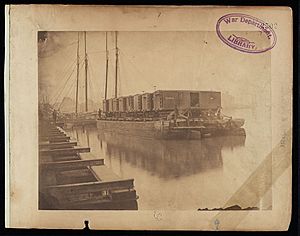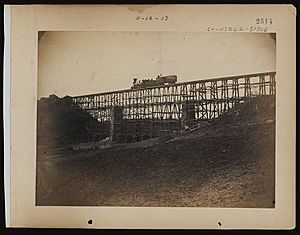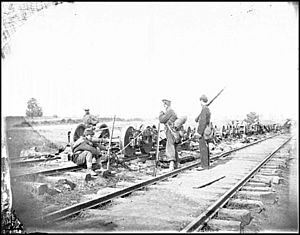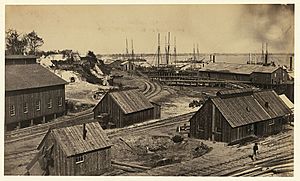United States Military Railroad facts for kids
Quick facts for kids United States Military Railroad |
|
|---|---|
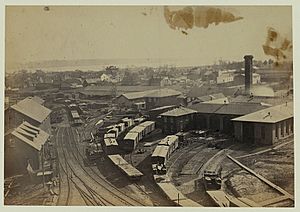
Orange & Alexandria Railroad rail yard in Alexandria, Virginia
|
|
| Active | February 1862 – 1865 |
| Country | |
| Branch | |
| Type | Transportation |
| Role | Strategic movement, operational resupply |
| Nickname(s) | "USMRR" |
| Commanders | |
| Notable commanders |
Daniel McCallum |
The U.S. Military Railroad (USMRR) was a special group created by the U.S. War Department. Its job was to run any railroad lines that the government took control of during the American Civil War. In January 1862, a law allowed President Abraham Lincoln to take over railroads and telegraph lines for military use. However, the USMRR mainly focused on Southern rail lines captured during the war. This organization for military rail transport was an early version of today's United States Army Transportation Corps.
Contents
The USMRR: How Railroads Changed War
The American Civil War was the first big war where railroads played a huge role. They were key for moving soldiers and supplies to battlefields. The USMRR was set up to manage this new way of moving things for the Union Army.
The USMRR was lucky to have experienced railroad experts join its team. Thomas A. Scott, a vice-president from the Pennsylvania Railroad, worked as an Assistant Secretary of War. He helped plan the USMRR's creation. Daniel C. McCallum, who used to run the New York and Erie Railroad, became the main boss of U.S. Railroads for the military. Herman Haupt, a former chief engineer, was in charge of building and moving things in Virginia.
These departments often worked on their own. But sometimes, the Secretary of War would get too involved, or different departments had overlapping jobs. This could make things tricky. Over time, the USMRR bought, built, or captured 419 locomotives (train engines) and 6,330 cars. This was in addition to the trains they borrowed from Northern railroads. When Colonel McCallum started, the USMRR only managed 7 miles of track. But by the end of the war, they controlled over 2,000 miles of military railroads and captured Southern lines.
Railroads in Northern Virginia: 1862
The Virginia Central Railroad and Orange and Alexandria Railroad were very important. They were the main supply routes for the Confederate and Union armies in this area.
Moving Troops to Chattanooga: A Huge Effort
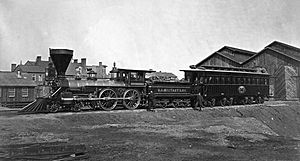
In the fall of 1863, Confederate railroads moved soldiers from Virginia to Georgia. This helped General Braxton Bragg's army. But only some of the troops arrived in time for the Chickamauga battle. After their defeat, Union troops were surrounded in Chattanooga, Tennessee.
On September 23, 1863, Secretary of War Edwin Stanton met with President Lincoln and other leaders. They discussed sending more troops to help the surrounded army. Stanton suggested moving 30,000 soldiers in just 5 days. Many doubted this was possible. Daniel McCallum of the USMRR was called in. After quick calculations, he said it could be done in 7 days!
President Lincoln gave the order. This began the largest troop movement by rail during the war. In 12 days, the USMRR moved about 25,000 men over 1,200 miles. This was a much bigger and faster move than the Confederacy's earlier one.
Planning the Great Troop Movement
On September 24, railroad experts met in Washington to plan the details. These included John W. Garrett, President of the Baltimore and Ohio Railroad (B&O), and Thomas Scott. The plan was complicated because different railroads used different track widths (called "gauges").
The USMRR managed the first part of the journey from Virginia. Then, the troops switched to other railroads. They traveled from Washington, D.C., through West Virginia, Ohio, and Indiana. They crossed the Ohio River twice, sometimes on special pontoon bridges. Finally, they used the Louisville and Nashville Railroad and the Nashville and Chattanooga Railroad to reach Bridgeport, Alabama. In total, 9 different railroads were used to get the troops from Virginia to Bridgeport.
The Journey Begins
Major General Joseph Hooker was put in charge of the eastern reinforcements. On September 25, the movement began. By the end of that day, 5,800 soldiers were on trains heading to Bridgeport. By September 27, 12,600 men, 33 cars of artillery, and 21 cars of baggage and horses were moving.
By September 30, the first trains reached Bridgeport. By October 3, all the main troops were there. But the job wasn't finished. The railroads then had to move all the army's equipment. This included wagons, ambulances, horses, and mule teams. The last soldiers arrived on October 8, 1863. By October 12, the USMRR and other railroads had moved both army corps, all their artillery, and all their gear. From Bridgeport, General Hooker's force marched to Chattanooga to help the Army of the Cumberland.
Supporting the Petersburg Siege: 1864
In 1864, General Ulysses S. Grant moved his army to try and capture Petersburg, Virginia. Petersburg was a key railroad hub that supplied the Confederate capital, Richmond, Virginia. The Union army couldn't capture Petersburg right away. So, they started a long siege, digging trenches to surround the city.
General Grant set up his main base at City Point, Virginia (now Hopewell). This became the main supply center for the Union armies in Virginia. The USMRR helped supply over 100,000 soldiers and more than 65,000 horses and mules. Food, equipment, and supplies arrived by ship at City Point's docks.
The USMRR started by rebuilding 9 miles of the Petersburg and City Point Railroad. As the Union army extended its siege lines, the USMRR built more tracks. They extended the rail service from City Point to positions behind the Union lines. Eventually, the USMRR added 21 more miles of track. This track partially circled Petersburg from the east to the southwest. Today, parts of this railroad extension are preserved at Fort Lee, Virginia. When Petersburg was finally abandoned in 1865, the USMRR's 25 engines and 275 other cars had traveled a total of 2,300,000 miles!
Key Leaders of the USMRR
- Brevet Major General Daniel McCallum


